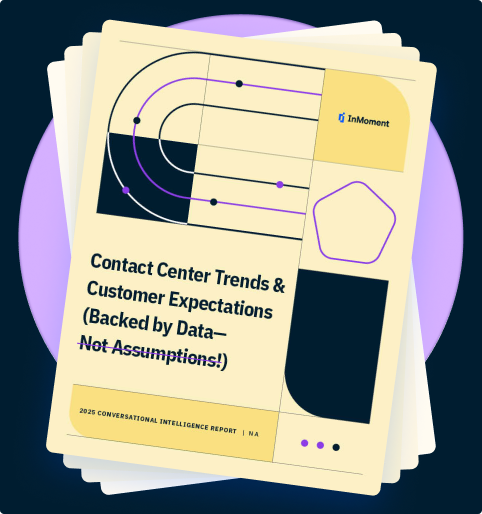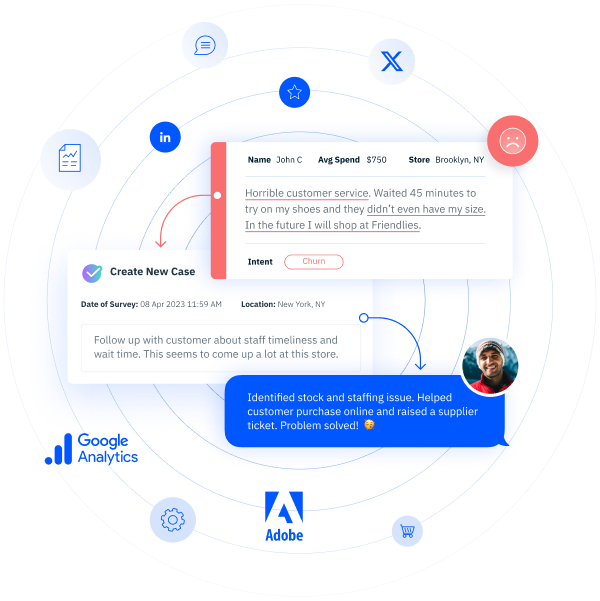Unlocking Deeper Insights: Using Conversational Intelligence for A/B Testing
Take A/B testing to the next level with conversational intelligence. Learn how AI-driven insights help optimize messaging, user experience, and conversions.
You can’t fully predict customer behavior from day one. People are unpredictable, and what resonates with one group might fall flat with another.
That’s where A/B testing shines. It helps you test messaging, support strategies, marketing campaigns, and experience variations to optimize interactions, streamline support processes, and improve the overall user experience.
But while traditional A/B testing tells you what performs better, conversational intelligence reveals why. It adds context to the data, uncovering customer sentiment, intent, and pain points that quantitative metrics alone can’t explain—fueling more targeted optimization and data-driven decision-making.
Let’s explore how conversational intelligence enhances the A/B testing process and how to implement it effectively.
Why Traditional A/B Testing Falls Short Without Conversational Intelligence
A/B testing (also known as split testing) is essential for customer experience optimization, but on its own, it can only take you so far in aligning CX efforts with broader business goals. Over time, traditional A/B testing tends to hit a wall for a few key reasons:
- It focuses on surface-level metrics like conversion rates, response times, customer satisfaction score (CSAT), and Net Promoter Score (NPS) but it lacks the qualitative context behind them. It doesn’t tell you why a customer felt frustrated, delighted, confused, or compelled to stay.
- It can be misleading when it fails to capture emotional responses. For example, a customer might complete a purchase or subscribe (boosting your conversion metrics), yet still feel dissatisfied with the experience. Traditional A/B testing would mark that as a win, even if that frustration puts long-term retention at risk.
How Conversational Intelligence Enhances A/B Testing
Conversational analytics software brings critical context to A/B testing. It goes beyond numbers to explain why customers behave a certain way, making it a powerful addition to your conversion analytics toolkit. When you understand the reasons behind user choices, you can refine experiences with greater precision.
Let’s break down how conversational intelligence strengthens A/B tests.
Uncovers Customer Pain Points and Friction Areas
If you’re testing different versions of your messaging, support strategy, or landing page, traditional A/B testing tools can tell you which variation performs better than the control group, but not explain the reasons behind it. That’s helpful, but it won’t show you where customers are getting stuck or what’s turning them away.
Conversational intelligence fills in those gaps. Analyzing service chats, voice transcripts, and chatbot interactions reveals the pain points and friction areas in the version that underperforms, giving you clear direction on what needs to be improved.
Example: An A/B test for a new support chatbot shows that Version A is the clear winner. CI analysis reveals that customers find Version B confusing because it lacks clear instructions and key functionality—insight that wouldn’t show up in standard performance metrics.
Automates Feedback Collection and Analysis
Let’s be honest: manual data collection from live chats, emails, call center logs, surveys, and support tickets is tedious, time-consuming, and nearly impossible to scale.
CI tools automate this process by using machine learning and natural language processing (NLP) to scan through large volumes of customer communication. They turn unstructured feedback into in-depth, actionable insights, helping you make smarter, faster decisions about what to run tests on next.
Example: CI detects complaints about hard-to-find contact options in one variation, highlighting a usability issue that shapes your next A/B test.
Identifies Customer Sentiment and Satisfaction Drivers
Metrics like click-through rates (CTRs) can tell you which A/B test version performs better, but they won’t tell you how customers actually feel about the experience. That’s where customer conversations come in.
CI tools use sentiment analysis to evaluate word choice, tone, and emotion across interactions. This helps you identify the experiences that generate positive sentiment and, just as importantly, the ones that don’t. With these insights from real user conversations, you can fine-tune future A/B tests to focus on what truly resonates.
Example: A brand tests two versions of a customer onboarding flow. CI sentiment analysis reveals that Version A causes frustration due to overly complex steps, even though completion rates are the same. Armed with this insight, the brand simplifies the experience in the next test to boost satisfaction.
Enhances Personalization and User Engagement
With 81% of consumers preferring brands that deliver personalized experiences, understanding your customers on a deeper level isn’t optional—it’s essential. Conversational intelligence helps you get there.
By analyzing how customers speak and what they care about, CI helps personalize the experience and sharpen your marketing strategy—from content and messaging to segmentation by behavior, preferences, and demographics. For example, you can apply CI insights to location-based campaigns to uncover what’s not working for users in a specific region and tailor the testing process to address that user group’s pain points directly.
These insights improve your next test and enable quick, meaningful adjustments that make customers feel heard and understood.
Example: One chatbot variation offers proactive solutions based on prior customer pain points, leading to higher engagement and fewer escalations.
Detects Emotional Reactions to Service Changes
Customer behavior isn’t always a reliable indicator of satisfaction. People may use a new feature or follow a script simply because they’re in a hurry or don’t want the hassle of switching providers. Traditional A/B testing might interpret this engagement as a success, even if the experience causes frustration.
CI fills in the emotional gaps. It uncovers patterns of confusion, irritation, or delight that typical metrics miss, helping you avoid rolling out changes that create hidden friction or long-term dissatisfaction.
Example: A new automated refund process is A/B tested. Both Version A and Version B receive similar engagement, but CI finds that Version B generates fewer complaints and more positive sentiment in support interactions.
Refines Customer Messaging and Support Strategies
Conversational intelligence takes the guesswork out of A/B tests by highlighting the exact words, requests, phrases, expressions customers use.
Instead of testing random messaging variations or support strategies, you can focus on the language and guidance that actually matters, like the phrasing of a call-to-action (CTA), chatbot guidance, or self-service instructions.
Example: CI reveals that customers repeatedly ask for a “talk to an agent” option. That insight leads to a clearer escalation pathway in the winning variation, improving both satisfaction and resolution rates.
Steps to Implement Conversational Intelligence in A/B Testing
Conversational intelligence is the lens that sharpens your A/B testing vision. It provides context (the why behind customer choices) that helps fine-tune tests and accelerate CX improvements. But to unlock its full value, it’s important to implement it thoughtfully and avoid common mistakes, like relying only on quantitative data or overlooking emotional drivers in customer conversations.
Here’s how to get started:
1. Identify Key Conversational Data Sources (Chatbots, Customer Support Logs, Social Media Comments)
Capturing valuable insights starts with assessing a variety of customer touchpoints. The more channels you analyze, the more complete your view will be of customer preferences, concerns, and questions.
Collect conversational data from multiple sources (like social media comments, chatbot logs, support transcripts, call recordings, and feedback forms) to ensure your A/B testing process reflects the full spectrum of the customer experience.
2. Use AI-Powered Conversational Intelligence Tools to Analyze Themes, Sentiment, and User Intent
Manually reviewing thousands of customer interactions isn’t realistic, and limiting your insights to a small sample size can lead to skewed or incomplete conclusions. That’s where AI-powered tools come in.
Conversational intelligence platforms act as advanced analytics tools, helping you move beyond raw feedback to spot actionable trends. They can detect user sentiment, recurring themes, and user intent in real time. These tools help you uncover patterns, like frustrations around your checkout process, that directly inform A/B test decisions and future CX refinements.
3. Integrate Conversational Insights With A/B Test Results
Once you’ve implemented your AI-powered CI tool, the next step is to combine its insights with your existing A/B test metrics. For example, if traditional A/B testing shows that customers prefer Version B, conversational intelligence can help uncover the why behind that preference, like clearer messaging, better support tone, or fewer points of friction.
Blending these insights moves your A/B testing beyond surface-level performance data, giving you a clearer view of how to optimize the experience based on customer perception, not just user behavior.
4. Iterate and Refine A/B Test Variations Based on These Insights
Conversational intelligence insights are only as valuable as the actions you take on them. Use what you learn to continuously refine your A/B test variations—whether that means updating the messaging, adjusting design elements on a webpage, or simplifying processes.
For example, if CI data shows that customers describe your pricing page in Version B as “confusing,” revise the structure and run another test. Continue iterating until customer sentiment improves and the data confirms you’ve found a version that truly works.
Gain Deeper Customer Insights With InMoment
A/B testing shows what performs better, but conversational intelligence reveals why. Together, they help your team move beyond surface metrics to uncover what truly drives customer behavior, improves the user experience, and accelerates CX optimization.
To get the most from your A/B testing process, invest in a CI tool with AI-powered analytics. These tools help you quickly identify patterns, sentiment, and intent across high volumes of customer interactions.
InMoment turns conversation data into a competitive edge. Our AI-powered customer experience platform analyzes interactions across contact center calls, chats, surveys, and more—highlighting preferences, friction points, and emotional responses. These insights show why one A/B test variation outperforms another so you can iterate faster, improve with confidence, and deliver experiences that truly resonate.
Schedule a demo to see how InMoment’s AI-powered CX platform can help you elevate your A/B testing strategy!
















